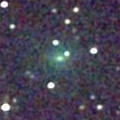
|
It brightened rapidly in December. Now it is bright as 10.6 mag (Mar. 8, Michael Jager). It will approach to Earth down to 0.46 a.u. in April, and it is expected to brighten up to 9 mag and to be observable in excellent condition.
Date(TT) R.A. (2000) Decl. Delta r Elong. m1 Best Time(A, h)
Mar. 13 20 27.63 -9 4.2 1.449 1.045 46 10.5 4:31 (265, 23)
Mar. 20 20 17.58 -6 59.3 1.261 1.072 55 10.3 4:38 (256, 30)
|

|
New bright comet. Now it is very bright as 11.0 mag (Mar. 2, Piotr Guzik). In the Northern Hemisphere, it stays observable in the evening low sky until early June while the comet will be fading. It is not observable in the Southern Hemisphere.
Date(TT) R.A. (2000) Decl. Delta r Elong. m1 Best Time(A, h)
Mar. 13 0 30.20 21 38.8 1.668 0.926 28 11.3 19:46 (104,-20)
Mar. 20 1 7.43 25 39.4 1.671 0.964 30 11.5 19:35 (110,-18)
|
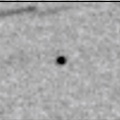
|
It will brighten up to 11.5 mag in spring. However, the condition is very bad in this apparition. Appearing in the morning sky in the Southern Hemisphere. In the Northern Hemisphere, it will appear in the morning sky in June.
Date(TT) R.A. (2000) Decl. Delta r Elong. m1 Best Time(A, h)
Mar. 13 21 47.53 -14 21.5 2.215 1.418 28 11.6 4:31 (281, 9)
Mar. 20 22 11.04 -12 59.3 2.195 1.413 29 11.6 4:38 (278, 11)
|
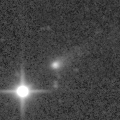
|
It brightened rapidly. Now it is very bright as 12.8 mag (Mar. 8, Michael Jager). It is expected to brighten up to 11 mag from spring to summer, and it stays observable in good condition for a long time.
Date(TT) R.A. (2000) Decl. Delta r Elong. m1 Best Time(A, h)
Mar. 13 14 7.55 32 35.7 1.706 2.493 133 12.5 2:46 (180, 23)
Mar. 20 14 7.30 33 21.8 1.641 2.448 135 12.3 2:18 (180, 22)
|

|
Now it is bright as 12.9 mag (Feb. 9, Chris Wyatt). It stays 12 mag until March. In the Southern Hemisphere, it stays observable in good condition after this. In the Northern Hemisphere, it will never be observable after this.
Date(TT) R.A. (2000) Decl. Delta r Elong. m1 Best Time(A, h)
Mar. 13 3 2.19 -80 15.7 2.063 2.147 81 12.4 19:46 ( 12, 39)
Mar. 20 3 21.40 -75 51.2 2.127 2.201 80 12.6 19:35 ( 17, 41)
|
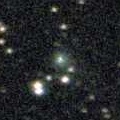
|
Now it is 13.4 mag (Mar. 5, Thomas Lehmann). It will brighten up to 10 mag in winter in 2022. In the Northern Hemisphere, it stays observable in good condition for a long time. In the Southern Hemisphere, it is not observable until November.
Date(TT) R.A. (2000) Decl. Delta r Elong. m1 Best Time(A, h)
Mar. 13 1 46.62 51 35.0 4.852 4.466 61 13.0 19:46 (139,-22)
Mar. 20 1 58.67 51 23.2 4.882 4.430 57 13.0 19:35 (138,-22)
|
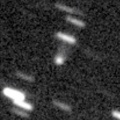
|
It will brighten up to 13 mag from spring to summer. In the Southern Hemisphere, it stays observable in good condition for a long time. In the Northern Hemisphere, it is not observable until July in 2022.
Date(TT) R.A. (2000) Decl. Delta r Elong. m1 Best Time(A, h)
Mar. 13 18 26.62 -61 55.0 3.737 3.712 80 13.6 4:31 (330, 54)
Mar. 20 18 41.29 -63 36.2 3.650 3.697 84 13.5 4:38 (335, 55)
|

|
It brightened up to 10.5 mag in early February (Feb. 6, Marco Goiato). Now it is fading rapidly. It has already faded down to 14.6 mag (Mar. 6, Michael Jager). In the Northern Hemisphere, it stays observable in excellent condition after this. In the Southern Heimsphere, it will be unobservable soon.
Date(TT) R.A. (2000) Decl. Delta r Elong. m1 Best Time(A, h)
Mar. 13 5 5.20 42 53.9 1.278 1.580 87 13.5 19:46 (158, 7)
Mar. 20 5 0.55 45 32.6 1.465 1.626 80 14.1 19:35 (155, 3)
|
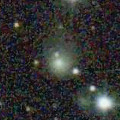
|
Now it is 13.8 mag (Mar. 8, Michael Jager). It is expected to be observable at 5-6 mag for a long time from 2022 to 2023. In the Northern Hemisphere, it is not observable at the high light from 2022 summer to 2023 summer. In the Southern Hemisphere, it stays extremely low for a while. But it will be observable in good condition at the high light.
Date(TT) R.A. (2000) Decl. Delta r Elong. m1 Best Time(A, h)
Mar. 13 18 26.17 37 45.5 6.961 6.880 81 13.6 4:31 (210, 9)
Mar. 20 18 27.39 38 20.6 6.850 6.824 84 13.5 4:38 (203, 12)
|
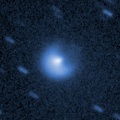
|
Now it is 13.1 mag (Feb. 13, Thomas Lehmann). It is already unobservable in the Southern Hemisphere. It will be unobservable in April also in the Northern Hemisphere.
Date(TT) R.A. (2000) Decl. Delta r Elong. m1 Best Time(A, h)
Mar. 13 2 40.79 24 28.7 6.401 5.864 53 13.8 19:46 (123, 3)
Mar. 20 2 45.66 24 42.0 6.489 5.866 47 13.8 19:35 (121, 1)
|
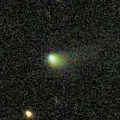
|
Now it is 15.5 mag (Jan. 19, Slooh.com Chile Observatory, La Dehesa). It stays 13-14 mag from 2020 to 2021. It will be observable in good condition after this in the Southern Hemisphere. It locates somewhat low in the Northern Hemisphere.
Date(TT) R.A. (2000) Decl. Delta r Elong. m1 Best Time(A, h)
Mar. 13 18 37.74 -23 17.1 2.982 2.866 73 14.0 4:31 (263, 53)
Mar. 20 18 46.64 -23 34.9 2.892 2.867 78 14.0 4:38 (259, 58)
|
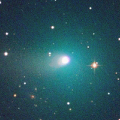
|
Brightened rapidly, and it brightened up to 9.7 mag in November (Nov. 15, Chris Wyatt). Now it is fading. It has already faded down to 13 mag (Feb. 19, Giuseppe Pappa). In the Northern Hemisphere, it stays observable in good condition for a long time. In the Southern Hemisphere, it locates extremely low after this.
Date(TT) R.A. (2000) Decl. Delta r Elong. m1 Best Time(A, h)
Mar. 13 4 45.63 40 52.3 1.672 1.843 83 14.0 19:46 (154, 7)
Mar. 20 5 6.72 40 53.8 1.779 1.892 80 14.3 19:35 (154, 8)
|

|
It brightened up to 5.6 mag in early December (Dec. 9, Marco Goiato). In mid December, it was visible at about 3 mag in the SOHO spacecraft images (Dec. 18, Hirohisa Sato). Now it is not observable. It will appear in the morning sky again in April. But then it will be fainter than 15 mag.
Date(TT) R.A. (2000) Decl. Delta r Elong. m1 Best Time(A, h)
Mar. 13 22 43.76 4 41.8 2.840 1.893 14 14.0 4:31 (273,-13)
Mar. 20 22 55.65 6 3.4 2.935 2.002 16 14.4 4:38 (269, -9)
|
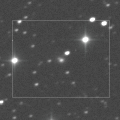
|
Now it is 14.4 mag (Jan. 20, iTelescope Observatory, Siding Spring). It will brighten up to 13.5 mag in spring. In the Southern Hemisphere, it stays observable in good condition for a long time. In the Northern Hemisphere, it will be getting higher and becoming observable slowly.
Date(TT) R.A. (2000) Decl. Delta r Elong. m1 Best Time(A, h)
Mar. 13 17 39.70 -39 39.7 3.283 3.373 86 14.4 4:31 (290, 68)
Mar. 20 17 32.88 -39 22.9 3.138 3.367 94 14.3 4:38 (293, 76)
|
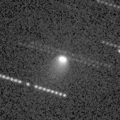
|
It brightening very rapidly up to 12.5 mag in early February (Feb. 8, Michael Jager). Now it is fading. But it is still bright as 12.3 mag (Mar. 2, Michael Jager). In the Northern Hemisphere, it stays observable in excellent condition. It will be observable in good condition after this also in the Southern Hemisphere.
Date(TT) R.A. (2000) Decl. Delta r Elong. m1 Best Time(A, h)
Mar. 13 4 17.95 2 34.1 0.971 1.151 71 14.3 19:46 (123, 35)
Mar. 20 4 14.57 -1 58.1 1.145 1.146 64 14.6 19:35 (115, 34)
|
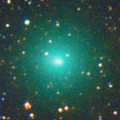
|
It brightened up to 8.2 mag in autumn (Oct. 13, Chris Wyatt). Now it is fading. It has already faded down to 13.0 mag (Feb. 14, Sandor Szabo). It is not observable after this.
Date(TT) R.A. (2000) Decl. Delta r Elong. m1 Best Time(A, h)
Mar. 13 0 56.59 4 15.8 3.046 2.161 22 14.3 19:46 ( 92, -5)
Mar. 20 1 10.14 5 46.5 3.124 2.207 19 14.6 19:35 ( 93, -7)
|

|
Now it is 14.2 mag and visible visually (Jan. 25, Chris Wyatt). It is expected to brighten up to 11.5 mag in 2022. It is observable in excellent condition in the Southern Hemisphere. In the Northern Hemisphere, it is observable in the extremely low sky until May.
Date(TT) R.A. (2000) Decl. Delta r Elong. m1 Best Time(A, h)
Mar. 13 7 59.33 -36 28.4 5.095 5.613 116 14.5 20:34 ( 0, 89)
Mar. 20 7 58.91 -35 28.6 5.096 5.578 114 14.5 20:06 ( 0, 90)
|
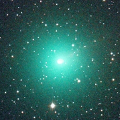
|
It brightened up to 7.3 mag in November (Nov. 7, Marco Goiato). Now it is fading. It has already faded down to 14.2 mag (Mar. 5, Thomas Lehmann). In the Northern Hemisphere, it stays observable in excellent condition for a long time. In the Southern Hemisphere, it stays locating extremely low after this.
Date(TT) R.A. (2000) Decl. Delta r Elong. m1 Best Time(A, h)
Mar. 13 6 34.07 46 36.6 1.864 2.299 102 14.8 19:46 (174, 8)
Mar. 20 6 46.12 45 58.9 2.008 2.372 98 15.1 19:35 (173, 9)
|
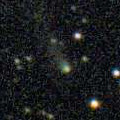
|
Now it is 16.2 mag (Feb. 22, Thomas Lehmann). It will stay at 14 mag for a long time from 2021 to 2022. It stays observable in good condition after this while brightening gradually. Although it was observed at 15 mag in 2020 autumn, it is fainter than this ephemeris recently.
Date(TT) R.A. (2000) Decl. Delta r Elong. m1 Best Time(A, h)
Mar. 13 18 23.57 2 14.2 5.438 5.308 77 14.9 4:31 (231, 39)
Mar. 20 18 23.47 2 5.1 5.309 5.290 83 14.8 4:38 (222, 44)
|
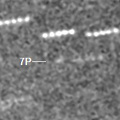
|
Now it is 16.2 mag, much fainter than predicted (Mar. 6, Thomas Lehmann). It will brighten up to 11 mag from May to August. In the Southern Hemisphere, it stays observable in excellent condition for a long time. In the Northern Hemisphere, it stays observable in good condition for a while. But it becomes extremely low after July.
Date(TT) R.A. (2000) Decl. Delta r Elong. m1 Best Time(A, h)
Mar. 13 16 55.19 9 41.8 1.007 1.527 99 15.2 4:31 (201, 43)
Mar. 20 17 15.18 9 34.7 0.931 1.482 100 14.9 4:38 (196, 44)
|
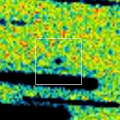
|
It will brighten up to 13 mag from spring to summer. In the Southern Hemisphere, it stays observable in good condition for a long time. In the Northern Hemisphere, it locates extremely low now, and it will be unobservable soon. Then it is not observable until September when it fades down to 15 mag.
Date(TT) R.A. (2000) Decl. Delta r Elong. m1 Best Time(A, h)
Mar. 13 20 14.19 -32 45.6 2.310 1.919 54 15.1 4:31 (287, 37)
Mar. 20 20 35.17 -34 43.8 2.184 1.865 58 14.9 4:38 (288, 40)
|

|
Now it is 15.8 mag (Jan. 16, Slooh.com Canary Islands Observatory). It is not observable until June.
Date(TT) R.A. (2000) Decl. Delta r Elong. m1 Best Time(A, h)
Mar. 13 23 34.80 4 47.1 3.067 2.086 7 15.1 19:46 ( 80,-22)
Mar. 20 23 48.87 6 51.5 3.075 2.091 7 15.2 4:38 (276,-20)
|

|
Now it is 15.8 mag (Jan. 14, Slooh.com Chile Observatory, La Dehesa). It stays 14-15 mag until the end of 2021. In the Southern Hemisphere, it stays observable in good condition for a long time, although it becomes extremely low temporarily from January to February. In the Northern Hemisphere, it is not observable until June.
Date(TT) R.A. (2000) Decl. Delta r Elong. m1 Best Time(A, h)
Mar. 13 22 31.45 -43 40.1 5.004 4.327 42 15.2 4:31 (312, 17)
Mar. 20 22 39.95 -42 37.5 4.961 4.326 45 15.1 4:38 (308, 21)
|

|
It had been observed as 8-9 mag for a long time in 2020. Now it is fading. It has already faded down to 16.1 mag (Feb. 25, Thomas Lehmann). It will be observable in good condition after this in the Southern Hemisphere. It locates extremely low after this in the Northern Hemisphere.
Date(TT) R.A. (2000) Decl. Delta r Elong. m1 Best Time(A, h)
Mar. 13 17 45.41 -35 54.5 4.011 4.056 85 15.2 4:31 (280, 67)
Mar. 20 17 46.69 -36 55.0 3.965 4.121 91 15.2 4:38 (283, 74)
|

|
Now it is 16.3 mag (Nov. 9, Toshihiko Ikemura, Hirohisa Sato). It will brighten up to 14.5 mag from spring to summer. In the Southern Hemisphere, it stays observable in excellent condition for a long time, although it becomes extremely low temporarily from January to February. In the Northern Hemisphere, it is not observable after this.
Date(TT) R.A. (2000) Decl. Delta r Elong. m1 Best Time(A, h)
Mar. 13 22 54.63 -42 33.9 3.358 2.680 40 15.3 4:31 (313, 13)
Mar. 20 23 6.20 -43 51.5 3.278 2.669 45 15.3 4:38 (312, 17)
|

|
First return of a new periodic comet which brightened up to 13 mag in 2009. It brightened up to 11.7 mag in January (Jan. 10, Marco Goiato). Now it is fading. It has already faded down to 15.8 mag (Mar. 5, Thomas Lehmann). It stays observable in good condition while the comet will be fading after this.
Date(TT) R.A. (2000) Decl. Delta r Elong. m1 Best Time(A, h)
Mar. 13 7 23.31 27 47.6 0.842 1.559 115 15.5 20:00 (180, 27)
Mar. 20 7 41.15 28 4.0 0.924 1.600 112 15.9 19:50 (180, 27)
|

|
Now it is 15.1 mag (Feb. 15, Thomas Lehmann). It stays 15 mag until summer. In the Southern Hemisphere, it stays observable in good condition until June. In the Northern Hemisphere, it is observable in the low sky from March to May.
Date(TT) R.A. (2000) Decl. Delta r Elong. m1 Best Time(A, h)
Mar. 13 6 4.09 -44 33.2 2.200 2.470 93 15.6 19:46 ( 49, 74)
Mar. 20 6 10.43 -40 30.6 2.169 2.422 92 15.5 19:35 ( 65, 74)
|
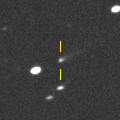
|
Now it is 15.5 mag (Feb. 9, Toshihiko Ikemura, Hirohisa Sato). It will brighten up to 13 mag in 2022. In 2021, it is observable at 15-16 mag in good condition.
Date(TT) R.A. (2000) Decl. Delta r Elong. m1 Best Time(A, h)
Mar. 13 13 40.65 -2 7.6 2.875 3.751 147 15.6 2:19 (180, 57)
Mar. 20 13 37.48 -1 48.6 2.809 3.735 154 15.5 1:48 (180, 57)
|

|
First return of a new periodic comet which brightened up to 14-15 mag in 2006. Now it is 15.5 mag (Feb. 15, Michael Jager). It will brighten up to 15-16 mag from February to March, and will be observable in good condition.
Date(TT) R.A. (2000) Decl. Delta r Elong. m1 Best Time(A, h)
Mar. 13 13 20.06 15 41.4 0.886 1.818 150 15.6 1:58 (180, 40)
Mar. 20 13 21.07 17 34.0 0.895 1.839 153 15.7 1:32 (180, 38)
|
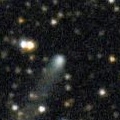
|
Now it is 15.5 mag (Feb. 9, Toshihiko Ikemura, Hirohisa Sato). It stays 15-16 mag until spring. In the Northern Hemisphere, it stays observable in good condition for a long time. In the Southern Hemisphere, it will be observable in the extremely low sky only in next spring.
Date(TT) R.A. (2000) Decl. Delta r Elong. m1 Best Time(A, h)
Mar. 13 19 21.51 35 4.0 5.228 4.972 69 15.6 4:31 (220, 5)
Mar. 20 19 22.18 36 51.4 5.190 4.997 73 15.6 4:38 (214, 8)
|

|
It has not been observed yet in this apparition. It will brighten up to 10 mag from summer to autumn, and it will be observable in excellent condition. It will be appearing in the morning sky soon.
Date(TT) R.A. (2000) Decl. Delta r Elong. m1 Best Time(A, h)
Mar. 13 21 54.51 -7 37.0 3.231 2.364 24 15.9 4:31 (276, 4)
Mar. 20 22 8.07 -6 28.3 3.153 2.321 27 15.7 4:38 (272, 8)
|
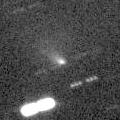
|
Now it is 15.8 mag (Mar. 2, Thomas Lehmann). It will be fading after this. In the Northern Hemisphere, it will be getting lower gradually, and will be too low to observe in May. It will be getting higher gradually in the Southern Hemisphere.
Date(TT) R.A. (2000) Decl. Delta r Elong. m1 Best Time(A, h)
Mar. 13 4 1.24 16 46.5 1.289 1.321 69 15.7 19:46 (131, 22)
Mar. 20 4 27.41 14 46.4 1.317 1.326 68 15.8 19:35 (132, 25)
|
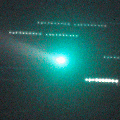
|
It brightened very rapidly in early December, and it brightened up to 10.0 mag in January (Jan. 7, Michael Jager). Now it is fading. However, it brightened in outburst in early March up to 12.9 mag (Mar. 3, Martin Masek). Two more components, H and I, were also observed. It stays observable for a long time in this apparition.
Date(TT) R.A. (2000) Decl. Delta r Elong. m1 Best Time(A, h)
Mar. 13 5 53.94 4 24.1 1.045 1.513 95 15.7 19:46 (152, 47)
Mar. 20 6 15.28 5 3.3 1.161 1.587 94 16.5 19:35 (154, 47)
|

|
Now it is not observable. It will be observable in June. But it will fade down to 17 mag at that time.
Date(TT) R.A. (2000) Decl. Delta r Elong. m1 Best Time(A, h)
Mar. 13 22 54.84 -8 53.3 2.543 1.578 10 15.7 4:31 (286, -7)
Mar. 20 23 14.00 -6 8.8 2.540 1.581 12 15.8 4:38 (282, -6)
|

|
Now it is 14.9 mag (Mar. 6, Thomas Lehmann). In the Northern Hemisphere, it stays observable for a long time while it is getting fainter slowly. In the Southern Hemisphere, it will never be observable again.
Date(TT) R.A. (2000) Decl. Delta r Elong. m1 Best Time(A, h)
Mar. 13 16 19.36 67 27.5 5.188 5.444 99 16.0 4:31 (182,-12)
Mar. 20 16 9.87 68 12.8 5.232 5.492 99 16.1 4:19 (180,-13)
|
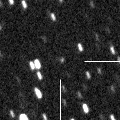
|
Now it is 16.2 mag (Feb. 19, Giuseppe Pappa). In the Northern Hemisphere, it stays observable at 15 mag for a long time from spring to early 2022. In the Southern Hemisphere, it is not observable until the end of 2021.
Date(TT) R.A. (2000) Decl. Delta r Elong. m1 Best Time(A, h)
Mar. 13 20 17.70 55 47.3 3.583 3.390 70 16.2 4:31 (212,-17)
Mar. 20 20 19.22 58 7.2 3.523 3.359 72 16.1 4:38 (208,-15)
|
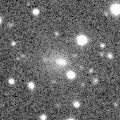
|
Brightened very rapidly up to 15.0 mag (Feb. 4, Michael Jager). Now it is 16.0 mag (Mar. 2, Michael Jager). It will be fading after this. It is observable in good condition in the Northern Hemisphere. It locates low in the Southern Hemisphere.
Date(TT) R.A. (2000) Decl. Delta r Elong. m1 Best Time(A, h)
Mar. 13 4 44.50 28 13.0 1.867 1.974 81 16.3 19:46 (147, 18)
Mar. 20 5 0.89 28 15.3 1.955 1.996 77 16.5 19:35 (147, 18)
|

|
Now it is 17.0 mag (Feb. 6, Toshihiko Ikemura, Hirohisa Sato). It is expected to brighten up to 13 mag in 2022. In the Southern Hemisphere, it stays observable in good condition for a long time. In the Northern Hemisphere, it stays observable until June when it brightens up to 16 mag. But it will not be observable at the high light.
Date(TT) R.A. (2000) Decl. Delta r Elong. m1 Best Time(A, h)
Mar. 13 13 47.89 -19 48.7 4.467 5.263 139 16.5 2:26 (180, 75)
Mar. 20 13 41.24 -20 9.5 4.349 5.216 147 16.4 1:52 (180, 75)
|

|
Now it is 16.5 mag (Feb. 9, Toshihiko Ikemura, Hirohisa Sato). It is observable at 16 mag from 2020 to 2021. In the Southern Hemisphere, it is not observable until summer.
Date(TT) R.A. (2000) Decl. Delta r Elong. m1 Best Time(A, h)
Mar. 13 22 55.00 42 44.8 6.587 5.947 46 16.5 4:31 (238,-33)
Mar. 20 22 58.90 42 36.8 6.612 5.948 44 16.5 4:38 (236,-28)
|

|
Now it is 16.8 mag (Feb. 17, Giuseppe Pappa). It stays observable at 16-17 mag from 2021 to 2022.
Date(TT) R.A. (2000) Decl. Delta r Elong. m1 Best Time(A, h)
Mar. 13 14 26.05 -22 4.7 4.262 4.966 130 16.6 3:04 (180, 77)
Mar. 20 14 23.37 -20 57.6 4.159 4.949 138 16.5 2:34 (180, 76)
|

|
Now it is 16.9 mag (Feb. 18, Giuseppe Pappa). It is observable at 16.5 mag from spring in 2020 to summer in 2021.
Date(TT) R.A. (2000) Decl. Delta r Elong. m1 Best Time(A, h)
Mar. 13 17 49.51 -12 5.1 4.725 4.744 85 16.7 4:31 (236, 55)
Mar. 20 17 47.05 -12 29.7 4.608 4.756 92 16.6 4:38 (224, 61)
|
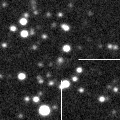
|
Now it is 16.6 mag (Nov. 9, Toshihiko Ikemura, Hirohisa Sato). It stays at 16-17 mag from 2020 to 2021. In the Northern Hemisphere, it stays observable in good condition for a long time. It is not observable in the Southern Hemisphere.
Date(TT) R.A. (2000) Decl. Delta r Elong. m1 Best Time(A, h)
Mar. 13 19 43.69 36 42.3 9.174 8.820 66 16.7 4:31 (223, 1)
Mar. 20 19 45.21 37 39.3 9.125 8.820 69 16.7 4:38 (217, 4)
|
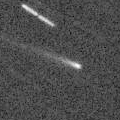
|
It brightened very rapidly up to 16.5 mag in January (Jan. 2, D. Buczynski). However, it is fading very rapidly in February. It has already faded down to 18.3 mag (Feb. 11, Toshihiko Ikemura, Hirohisa Sato). It is observable in excellent condition in the Northern Hemisphere. It locates somewhat low in the Southern Hemisphere.
Date(TT) R.A. (2000) Decl. Delta r Elong. m1 Best Time(A, h)
Mar. 13 4 20.44 25 40.1 1.458 1.543 75 16.9 19:46 (141, 17)
Mar. 20 4 43.78 26 48.8 1.526 1.572 73 17.1 19:35 (143, 17)
|
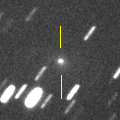
|
It brightened rapidly and became brighter than expected. Now it is 16.7 mag (Feb. 7, Toshihiko Ikemura, Hirohisa Sato). It is observable in good condition in the Northern Hemisphere. It locates somewhat low in the Southern Hemisphere.
Date(TT) R.A. (2000) Decl. Delta r Elong. m1 Best Time(A, h)
Mar. 13 4 41.44 20 48.9 1.939 2.009 79 16.9 19:46 (142, 24)
Mar. 20 4 56.32 20 27.6 2.029 2.029 75 17.1 19:35 (141, 24)
|

|
Now it is 17.7 mag (Feb. 8, Giuseppe Pappa). It will brighten up to 16.5 mag in summer.
Date(TT) R.A. (2000) Decl. Delta r Elong. m1 Best Time(A, h)
Mar. 13 17 35.32 -34 0.5 4.980 5.037 87 17.0 4:31 (275, 69)
Mar. 20 17 36.75 -33 26.4 4.852 5.023 94 16.9 4:38 (269, 76)
|

|
Now it is 16.3 mag (Oct. 17, ATLAS-MLO, Mauna Loa). It will be fading slowly.
Date(TT) R.A. (2000) Decl. Delta r Elong. m1 Best Time(A, h)
Mar. 13 18 28.41 -18 5.5 7.576 7.392 75 17.0 4:31 (254, 52)
Mar. 20 18 27.57 -17 44.7 7.475 7.415 82 17.0 4:38 (245, 58)
|

|
Now it is 17.5 mag (Feb. 23, Thomas Lehmann). Although it is an asteroid, it is brightening rapidly. It may brighten up to 11 mag in 2023. In the Northern Hemisphere, it stays observable in good condition for a long time. It locates extremely low in the Southern Hemisphere.
Date(TT) R.A. (2000) Decl. Delta r Elong. m1 Best Time(A, h)
Mar. 13 18 36.57 41 39.3 7.297 7.192 80 17.2 4:31 (209, 5)
Mar. 20 18 36.12 42 31.2 7.199 7.148 83 17.1 4:38 (203, 7)
|

|
Now it is 18.2 mag (Feb. 2, Thomas Lehmann). It is expected to brighten up to 12 mag in 2022. In the Southern Hemisphere, it stays observable in good condition for a long time. In the Northern Hemisphere, it is not observable until 2022 autumn.
Date(TT) R.A. (2000) Decl. Delta r Elong. m1 Best Time(A, h)
Mar. 13 2 44.06 -43 54.2 6.330 5.877 58 17.2 19:46 ( 59, 39)
Mar. 20 2 45.92 -43 23.2 6.307 5.827 57 17.2 19:35 ( 58, 36)
|
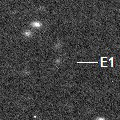
|
First return of a new periodic comet which brightened up to 16 mag in 2014. Now it is 17.4 mag (Mar. 6, Michael Jager). It will brighten up to 17 mag in spring, and it will be observable in good condition.
Date(TT) R.A. (2000) Decl. Delta r Elong. m1 Best Time(A, h)
Mar. 13 12 52.36 12 59.2 1.399 2.349 157 17.3 1:31 (180, 42)
Mar. 20 12 46.84 13 1.8 1.360 2.329 162 17.2 0:58 (180, 42)
|
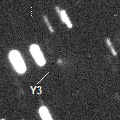
|
Now it is 17.0 mag (Feb. 15, Michael Jager). It stays 17.5 mag and observable in good condition until March.
Date(TT) R.A. (2000) Decl. Delta r Elong. m1 Best Time(A, h)
Mar. 13 14 57.76 24 42.1 1.598 2.325 125 17.4 3:36 (180, 31)
Mar. 20 14 53.70 30 10.8 1.615 2.367 128 17.5 3:04 (180, 25)
|
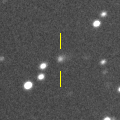
|
It brightened up to 16.1 mag in last winter (Mar. 18, 2020, Toshihiko Ikemura, Hirohisa Sato). Now it is 17.6 mag (Feb. 9, Toshihiko Ikemura, Hirohisa Sato). In 2021, it stays observable at 17-18 mag in good condition until early summer.
Date(TT) R.A. (2000) Decl. Delta r Elong. m1 Best Time(A, h)
Mar. 13 13 11.30 -19 4.1 6.044 6.899 147 17.5 1:50 (180, 74)
Mar. 20 13 9.63 -18 37.7 6.004 6.913 154 17.5 1:21 (180, 74)
|
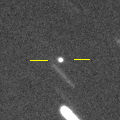
|
Now it is 17.9 mag (Mar. 2, Thomas Lehmann). It will be fading after this, and will be fainter than 18 mag in April. In the Northern Hemisphere, it stays observable in good condition for a long time after this. In the Southern Hemisphere, it will never be unobservable after this.
Date(TT) R.A. (2000) Decl. Delta r Elong. m1 Best Time(A, h)
Mar. 13 3 8.33 41 16.3 1.797 1.665 66 17.5 19:46 (139, -4)
Mar. 20 3 32.78 42 45.3 1.884 1.711 64 17.6 19:35 (141, -4)
|
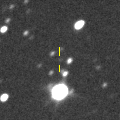
|
Now it is 18.0 mag (Feb. 8, Toshihiko Ikemura, Hirohisa Sato). It will brighten up to 17 mag from April to May, and it will be observable in good condition.
Date(TT) R.A. (2000) Decl. Delta r Elong. m1 Best Time(A, h)
Mar. 13 16 25.51 16 17.1 1.901 2.386 106 17.7 4:31 (190, 38)
Mar. 20 16 11.54 16 19.2 1.772 2.376 115 17.5 4:22 (180, 39)
|

|
Now it is 17.7 mag (Mar. 6, Michael Jager). It stays 17-18 mag for a long time from 2021 to 2023.
Date(TT) R.A. (2000) Decl. Delta r Elong. m1 Best Time(A, h)
Mar. 13 10 50.36 11 36.0 3.960 4.933 166 17.6 23:25 (180, 43)
Mar. 20 10 47.07 11 51.1 3.982 4.925 159 17.5 22:54 (180, 43)
|
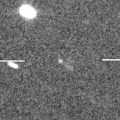
|
Now it is 17.3 mag (Mar. 6, Michael Jager). It is expected to brighten up to 10 mag in 2023. In the Northern Hemisphere, it stays observable in good condition until 2023 autumn. In the Southern Hemipshere, it stays extremely low until mid July, then it becomes unobservable for a while. But it becomes observable in good condition after 2023 summer.
Date(TT) R.A. (2000) Decl. Delta r Elong. m1 Best Time(A, h)
Mar. 13 12 59.95 35 11.6 6.953 7.760 141 17.6 1:38 (180, 20)
Mar. 20 12 55.25 35 58.6 6.900 7.708 141 17.6 1:06 (180, 19)
|
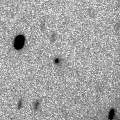
|
Now it is 17.9 mag (Mar. 6, Michael Jager). It will approach to Earth down to 0.2 a.u. in December, and it is expected to brighten up to 4 mag. In the Northern Hemisphere, it stays observable in good condition for a long time until December while the comet is brightening gradually. In the Southern Hemisphere, it is not observable until mid December.
Date(TT) R.A. (2000) Decl. Delta r Elong. m1 Best Time(A, h)
Mar. 13 13 30.23 56 55.4 3.760 4.359 121 17.8 2:09 (180, -2)
Mar. 20 13 16.98 58 28.6 3.701 4.283 119 17.7 1:28 (180, -3)
|
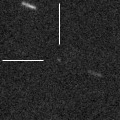
|
Now it is 17 mag (Feb. 18, Giuseppe Pappa). Although it is an asteroid, it is brightening rapidly. It stays 17-18 mag for a long time from 2021 to 2022. In the Southern Hemisphere, it stays observable in good condition for a long time. In the Northern Hemisphere, it is observable only until May.
Date(TT) R.A. (2000) Decl. Delta r Elong. m1 Best Time(A, h)
Mar. 13 8 36.55 -6 50.6 4.885 5.633 135 17.7 21:11 (180, 62)
Mar. 20 8 31.55 -6 55.7 4.947 5.617 128 17.7 20:39 (180, 62)
|
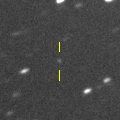
|
Now it is 18 mag (Feb. 8, Giuseppe Pappa). It stays observable at 18 mag for a long time until 2024.
Date(TT) R.A. (2000) Decl. Delta r Elong. m1 Best Time(A, h)
Mar. 13 15 31.10 -12 5.8 8.743 9.261 118 17.9 4:09 (180, 67)
Mar. 20 15 28.26 -11 44.3 8.624 9.249 126 17.8 3:39 (180, 67)
|

|
It stays 17-18 mag for a long time until 2026. In the Southern Hemisphere, it stays sobservable in good condition for a long time. It is not observable in the Northern Hemisphere.
Date(TT) R.A. (2000) Decl. Delta r Elong. m1 Best Time(A, h)
Mar. 13 9 8.69 -57 8.7 11.113 11.542 113 17.9 21:43 ( 0, 68)
Mar. 20 9 4.32 -56 55.3 11.098 11.526 113 17.8 21:11 ( 0, 68)
|

|
First return of a new periodic comet observed at 19 mag in 2015. It will brighten up to 17 mag in early summer, and it will be observable in good condition.
Date(TT) R.A. (2000) Decl. Delta r Elong. m1 Best Time(A, h)
Mar. 13 16 57.82 -11 0.5 1.062 1.550 97 18.0 4:31 (215, 62)
Mar. 20 17 17.05 -11 11.0 1.006 1.532 99 17.9 4:38 (208, 64)
|

|
Marsden group's comet. Three apparitions of this comet was confirmed in 1999, 2004 and 2010. It approached to Sun down to 0.044 a.u. on Feb. 28. After the perihelion passage, it may be observed on the ground from March to April.
Date(TT) R.A. (2000) Decl. Delta r Elong. m1 Best Time(A, h)
Mar. 13 21 34.00 -13 19.4 1.044 0.545 30 20.1 4:31 (278, 11)
Mar. 20 21 23.60 -15 13.2 1.101 0.738 40 22.2 4:38 (274, 22)
|

|
Five apparitions of this comet was confirmed in 1999, 2004, 2008, 2012 and 2016. It approached to Sun down to 0.04 a.u. on Jan. 17. It may be observed on the ground in December and February.
Date(TT) R.A. (2000) Decl. Delta r Elong. m1 Best Time(A, h)
Mar. 13 5 5.04 25 5.1 1.121 1.435 85 21.8 19:46 (150, 23)
Mar. 20 5 26.65 25 12.3 1.313 1.551 83 22.5 19:35 (151, 23)
|
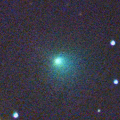
|
New periodic comet discovered in 2016. It had been predicted to return in 2024. But actually, it returned much earlier than predicted. It brightened very rapidly up to 11 mag in January (Jan. 16, Giuseppe Pappa). Now it is fading very rapidly. It has already faded out, fainter than 19.5 mag (Feb. 21, Katsumi Yoshimoto). In the Southern Hemisphere, it stays observable in excellent condition after this. In the Northern Hemisphere, it will never be observable after this.
Date(TT) R.A. (2000) Decl. Delta r Elong. m1 Best Time(A, h)
Mar. 13 18 59.79 -52 27.6 0.672 1.039 74 22.8 4:31 (313, 53)
Mar. 20 18 42.94 -52 15.8 0.687 1.137 82 24.4 4:38 (316, 60)
|
|
![]()
 C/2020 N1 ( PanSTARRS )
C/2020 N1 ( PanSTARRS ) 141P/Machholz 2
141P/Machholz 2 28P/Neujmin 1
28P/Neujmin 1 C/2018 N2 ( ASASSN )
C/2018 N2 ( ASASSN ) C/2020 M5 ( ATLAS )
C/2020 M5 ( ATLAS ) P/2020 U2 ( PanSTARRS )
P/2020 U2 ( PanSTARRS ) C/2020 Y2 ( ATLAS )
C/2020 Y2 ( ATLAS ) C/2019 T3 ( ATLAS )
C/2019 T3 ( ATLAS ) C/2020 H6 ( ATLAS )
C/2020 H6 ( ATLAS ) C/2017 Y2 ( PanSTARRS )
C/2017 Y2 ( PanSTARRS ) C/2019 O3 ( Palomar )
C/2019 O3 ( Palomar ) P/2020 T3 ( PanSTARRS )
P/2020 T3 ( PanSTARRS ) 277P/LINEAR
277P/LINEAR C/2020 O2 ( Amaral )
C/2020 O2 ( Amaral ) C/2017 U7 ( PanSTARRS )
C/2017 U7 ( PanSTARRS ) A/2019 U5
A/2019 U5 C/2020 R7 ( ATLAS )
C/2020 R7 ( ATLAS ) 413P/2020 W4 ( Larson )
413P/2020 W4 ( Larson ) C/2020 Y3 ( ATLAS )
C/2020 Y3 ( ATLAS ) C/2019 C1 ( ATLAS )
C/2019 C1 ( ATLAS ) 162P/Siding Spring
162P/Siding Spring C/2020 S8 ( Lemmon )
C/2020 S8 ( Lemmon ) 99P/Kowal 1
99P/Kowal 1 C/2020 V2 ( ZTF )
C/2020 V2 ( ZTF ) C/2021 A1 ( Leonard )
C/2021 A1 ( Leonard ) A/2020 F7
A/2020 F7 C/2020 F2 ( ATLAS )
C/2020 F2 ( ATLAS ) C/2019 E3 ( ATLAS )
C/2019 E3 ( ATLAS ) 417P/2021 B1 ( NEOWISE )
417P/2021 B1 ( NEOWISE ) P/1999 J6 = P/2004 V9 = P/2010 H3 ( SOHO )
P/1999 J6 = P/2004 V9 = P/2010 H3 ( SOHO ) 323P/SOHO
323P/SOHO 414P/2021 A3 ( STEREO )
414P/2021 A3 ( STEREO )![]()























































